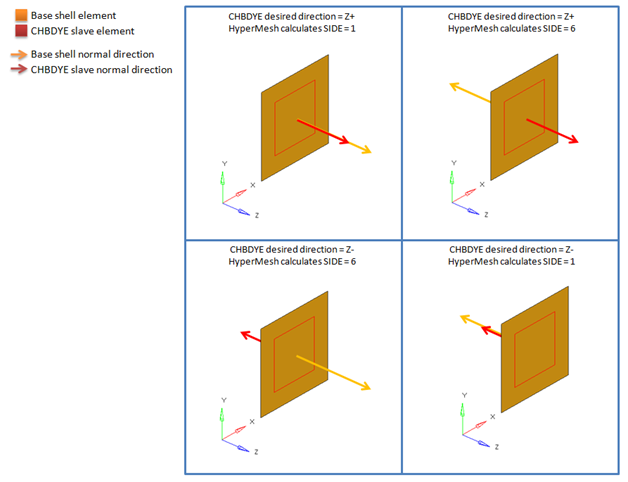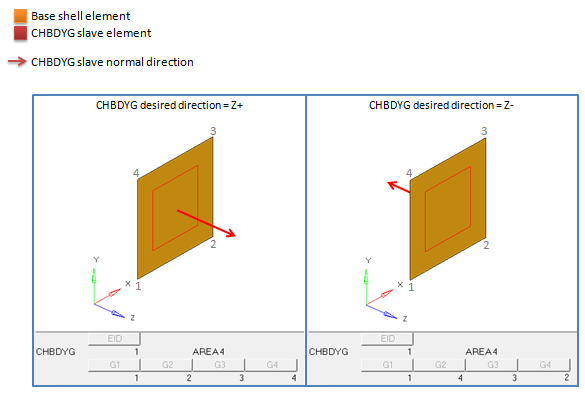Modeling of Thermal Surface Elements for Nastran |

|

|

|

|
|
Modeling of Thermal Surface Elements for Nastran |

|

|

|

|
Keywords: CHBDYE, CHBDYG, Conduction, Convection, Radiation, SOL400, Sol 400
HyperMesh supports modeling of boundary condition surface elements used in heat transfer solution sequences in Nastran (such as SOL400). HyperMesh currently has full support of CHBDYE elements, and partial support of CHBDYG elements, as covered in the table below:
Thermal Surface Element |
Import |
Export |
Edit |
Create |
CHBDYE |
Y |
Y |
Y |
Y |
CHBDYG |
Y |
Y |
Y |
N |
These cards are represented as slave elements as part of a CONDUCTION, CONVECTION, or RADIATION group in HyperMesh, and are created through the Interfaces panel.
Conduction
| • | Group type = CONDUCTION |
| • | Group Card Image = NONE |
| • | Slave element type = CHBDYE/CHBDYG |
| • | Additional associated cards = NONE |
Convection
| • | Group type = CONVECTION |
| • | Group Card Image = PCONV |
| • | Slave element type = CHBDYE/CHBDYG |
| • | Additional associated cards = CONV: Represented as a checkbox inside slave element card preview. |
Radiation
| • | Group type = RADIATION |
| • | Group Card Image = RADM |
| • | Slave element type = CHBDYE/CHBDYG |
| • | Additional associated cards = VIEW: Represented as a loadcollector in HyperMesh |
CHBDYE Side Conventions for 3D Elements
HyperMesh automatically calculates the appropriate value of the SIDE parameter when creating CHBDYE slaves on solid elements using the add > slave: face option inside the Interfaces panel, according to the specified face nodes and break angle.

CHBDYE Side Conventions for 2D Elements
For CHBDYE slaves on 2D shell elements, HyperMesh will automatically assign a SIDE parameter value of 1 (top) or 6 (bottom), depending on CHBDYE normal direction. Use the Normals panel inside the Tool menu page to change CHBDYE normal direction.
Regardless of base shell element normal direction, visualization of CHBDYE normal in HyperMesh will always identify the direction the CHBDYE slave is facing.
| Example: | CHBDYE slave on a 2d shell element. The following figure shows the resulting SIDE value calculated by HyperMesh under 4 different scenarios: |

CHBDYG Side Conventions for 2D Elements
Visualization of CHBDYG normal in HyperMesh identifies the direction the CHBDYG slave is facing. CHBYG node order is adjusted accordingly. Use the Normals panel inside the Tool menu page to change CHBDYG normal direction.
| Example: | CHBDYG slave on a 2d shell element. The following figure shows the resulting CHBDYG node order assigned by HyperMesh under 2 different scenarios: |
